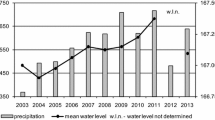Abstract
During a bloom of the brown phototrophic sulfur bacteriumChlorobium phaeobacteroides in Lake Kinneret the decisive hydrochemical parameters, pH, pH2S and pe (p=−log activity) were monitored in situ and related to the phototrophic bacterial bloom. The measured data in dicate a strong influence of the phototrophic bacteria on the metalimnic sulfide concentration and on the prevailing redox conditions. The intensity of theC. phaeobacteroides bloom, which appeared in two distinct peaks, could be related to vertical changes of the thermocline.
Similar content being viewed by others
References
Almgren T, Hagstrom I (1974) The oxidation rate of sulphide in sea water, Water Res. 8: 395–400
Baas Becking LG, Kplan IR, Moore D (1960) Limits of the natural environment in terms of pH and oxidation-reduction potentials. J Geol 68: 243–284
Bergstein Ben Dan T, Henis Y, Cavari BZ (1979) Investigations on the photosynthetic sulfur bacteriumChlorobium phaeobacteroides causing seasonal blooms in Lake Kinneret. Can J Microbiol 25:999–1007
Berman T, Pollingher U (1974) Annual and seasonal variations of phytoplankton, chlorophyll and photosynthesis in Lake Kinneret, Limnol Oceanogr 19:31–54
Berman T, Eppley RW (1974) The measurement of phytoplankton parameters in nature. Sci Progr 61:219–239
Berner RA (1963) Electrode studies of hydrogen sulfide in marine sediments. Geochem Cosmochem Acta 27:563–575
Blackburn TH, Kleiber P, Fenchel T (1975) Photosynthetic sulfide oxidation in marine sediments. Oikos 26:103–108
Boulegue J, Michard G (1979) Sulfur speciations and redox processes in reducing environments. In: Jenne EA (ed) Chemical Modelling in Aqueous Systems. ACS Symp Ser 93: 25–50
Caldwell, DE, Tiedje JM (1975) The structure of anaerobic bacterial communities in the hypolimnion of several Michigan lakes. Can J Microbiol 21:362–385
Dubinsky Z, Berman T (1979) Seasonal changes in the spectral composition of downwelling irradiance in Lake Kinneret (Israel). Limnol Oceanogr 24:652–663
Eckert W, Frevert T (1984) In situ monitoring of hydrogen sulfide in water and sediment of Lake Kinneret, Israel, 4th Symp on Ion-Selective Electrodes, Matrafured, Hungary, pp 359–371
Eckert W, Frevert T, Bergstein T, Cavari BZ (1986) Competitive development ofthiocapsa roseopersicina andChlorobium phaeobacteroides in Lake Kinneret, Can J Microbiol 32:917–921
Eckert W, Frevert T, Trüper HG (1990) A new liquid-junction free probe for thein situ determination of pH, pH2S and redox values. Water Res.: in press
Frevert T, Galster H (1978) Schnelle und einfache Methode zur in situ Bestimmung von Schwefelwasserstoff in Gewässern und Sedimenten, Swiss J Hydrol 40:199–208
Frevert T (1980) Determination of hydrogen sulfide in saline solutions. Swiss J Hydrol 42: 255–268
Frevert T (1983) Hydrochemisches Grundpraktikum, Birkhäuser Verlag, Basel
Frevert T (1984) Can the redox conditions in natural waters be predicted by a single parameter? (with a comment by Stumm W). Swiss J Hydrol 46:269–280
Gorlenko WM (1977) Die phototrophen Bakterien in den stratifizierten Seen und ihre Ökologie. In: Daubner (ed), 2nd Internat Hydro-Microbiol Symp, Bratislava, pp 91–112
Guerrero R, Pedros-Alio C, Esteve I, Mas J (1982) Communities of phototrophic sulfur bacteria in lakes of the Spanish Mediterranean region. Acta Academiae Aboensis Ser B 47:125–151
Klein B, Sournia A (1987) A daily study of the diatom spring bloom at Roscoff (France) in 1985. II. Phytoplankton pigment composition studied by HPLC analysis. Mar Ecol Prog Ser 37:265–275
Mantoura RFC, Llewellyn CA (1983) The rapid determination of algal chlorophyll and carotenoid pigments and their breakdown products in natural waters by reverse phase highperformance liquid chromatography. Anal Chim Acta 151: 297–314
Parkin TB, Brock TD (1980) Photosynthetic bacterial production in lakes: The effect of light intensity. Limnol Oceanogr 25:711–718
Peiffer S, Frevert T (1987) Potentiometric determination of heavy metal sulphide solubilities using a pH2S(glass/Ag,Ag2S) electrode cell, Analyst 112:951–954
Pfennig N (1965) Anreicherungskulturen fur rote und grüne Schwefelbakterien. Zentralbl Bakteriol Parasitenkd Infektionskr Hyg Abt 1:179–189
Pfennig N (1967) Photosynthetic bacteria. Ann Rev Microbiol 21:285–324
Pfennig N (1975) The phototrophic bacteria and their role in the sulfur cycle. Plant Soil 43: 9–14
Seruya C (ed) (1978) Lake Kinneret, Dr. W Junk Publisher, Amsterdam
Sorokin YI (1970) Interrelation between sulfur and carbon turnover in meromictic lakes, Arch Hydrobiol 66:391–446
Stal LJ, Van Gemerden H, Krumbein WE (1984) The simultaneous assay of chlorophyll and bacteriochlorophyll in natural microbial communities. J Microbiol Meth 2:295–306
Steenbergen CLM, Korthals HJ, Van Nes M (1987) Ecological observations on phototrophic sulfur bacteria and the role of these bacteria in the sulfur cycle of monomictic Lake Vechten (The Netherlands). Acta Academiae Aboensis 47:97–115
Stumm W (1981) Aquatic chemistry, Wiley, New York
Takahashi M, Ichimura S (1970) Photosynthetic properties and growth of photosynthetic bacteria in lakes. Limnol Oceanogr 15:929–944
Trüper HG, Genovese S (1968) Characterization of photosynthetic sulfur bacteria causing red water in Lake Faro Sicily. Limnol Oceanogr 13:225–232
Trüper HG (1978) Sulfur metabolism. In: Clayton RK, Systron WR (eds) The photosynthetic bacteria, Plenum Press, New York, pp 677–690
Trüper HG (1981) Photolithotrophic sulfur oxidation. In: Bothe H, Trebst A (eds) Biology of inorganic nitrogen and sulfur. Springer Berlin, pp 199–211
Yacobi YZ, Eckert W, Trüper HG, Berman T (1990) High performance liquid chromatography detection of phototrophic bacterial pigments in aquatic environments. Microbial Ecol 19: 127–136
Zapata M, Ayala AM, Franco JM, Garrido JL (1987) Separation of chlorophylls and their degradation products in marine phytoplankton by reverse-phase high-performance liquid chromatography Chromatographia 23:26–30
Author information
Authors and Affiliations
Rights and permissions
About this article
Cite this article
Eckert, W., Yacobi, Y.Z. & Trüper, H.G. A bloom of a brown phototrophic sulfur bacterium in lake kinneret: Hydrochemical aspects. Microb Ecol 20, 273–282 (1990). https://doi.org/10.1007/BF02543882
Received:
Revised:
Issue Date:
DOI: https://doi.org/10.1007/BF02543882




